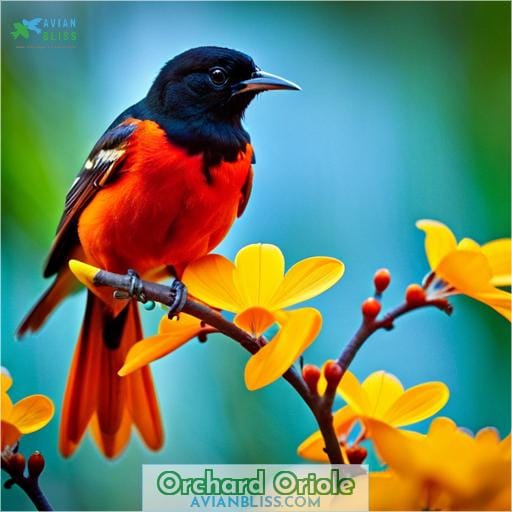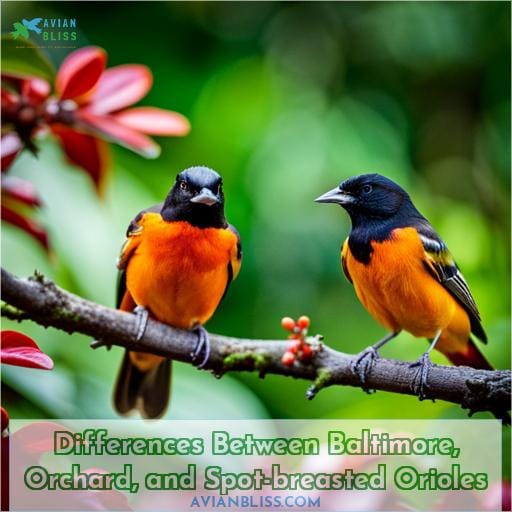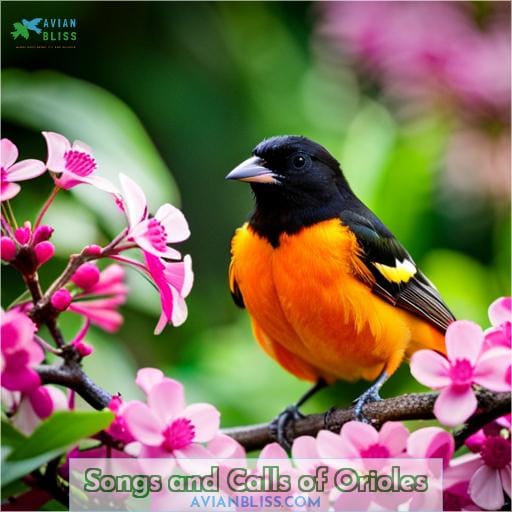This site is supported by our readers. We may earn a commission, at no cost to you, if you purchase through links.
 Ready to explore the world of oriole birds in Florida? These beautiful creatures can be seen year-round, with some species migrating through twice a year. We’ll take a look at three types of orioles found in the Sunshine State: Baltimore Oriole, Orchard Oriole, and Spot-breasted Orioles.
Ready to explore the world of oriole birds in Florida? These beautiful creatures can be seen year-round, with some species migrating through twice a year. We’ll take a look at three types of orioles found in the Sunshine State: Baltimore Oriole, Orchard Oriole, and Spot-breasted Orioles.
Let’s discover their unique appearances, behavioral habits, and range, as well as migration patterns – so you can spot these stunningly colored birds near you! With information on nesting and breeding habits too, we’ll cover all aspects of these amazing feathered friends that call Florida home.
Table Of Contents
Key Takeaways
- Baltimore Orioles migrate to Florida from October to April and can be attracted with oranges, grape jelly, and nectar feeders.
- Orchard Orioles make brief visits to Florida during spring and fall, breeding in the north and migrating to Mexico.
- Spot-breasted Orioles are non-migratory and were introduced to Florida in the 1940s. They prefer tropical plants and are known for their loud songs.
- Understanding the migration patterns of orioles is important for conservation efforts and habitat restoration in Florida.
Types of Orioles in Florida
You see striking silhouettes soaring through sunny skies scanning for succulent citrus in the Sunshine State. The Baltimore Oriole migrates from October through April; an easy way to identify this black and orange species is their white wingbars.
Only visiting northern Florida in the summer and during migration, the dark orange plumaged Orchard Oriole prefers habitats near wetlands.
The yellow and black Spot-breasted Oriole now calls southern Florida home after its introduction in the 1940s; juveniles resemble female Baltimores, so look for the namesake spotted breast to differentiate.
Though populations declined after severe winters in the 1970s and 80s, restoring habitats like open woodlands and gardens with fruit-bearing plants continues oriole conservation so these tropical beauties remain in Florida.
Baltimore Oriole
Visually pleasing with orange plumage and black wing markings, the Icterus galbula, or Baltimore Oriole, is a welcome spring and summer visitor throughout Florida. Found across the state, this striking bird delights observers as it darts among trees searching for insects, fruit, and nectar, with grape jelly and oranges among its favorite foods.
Appearance and Behavior
The Baltimore Orioles are the most strikingly colorful birds in Florida, can’t y’all resist admiring their brilliant orange and black plumage? From springtime’s passion of song through raising young to migrating south, they add vibrancy.
Watch females flutter collecting nesting fibers as males trumpet melodies defending territories. Thrill seeing males return with the sun from Mexico clad in fiery plumage. Can’t help delighting when these beauties visit our yards.
Try offering oranges and enjoy their singing from treetop perches. Let’s appreciate Baltimore Orioles enriching Florida’s avifauna.
Habitat and Range
Mid mangroves and palms, this stunning orange beauty graces Florida’s woods and parks. Though eastern winters drive home northern migrants, Icterus galbula nests under the sun’s steady caress. Seeking summer bounty, they return each April with open beaks, as this colony probes blossoms, plucks insects, and feasts on ripe berries.
Cherish the orange flash among jungles of green, a brilliant brushstroke animating the canvas. Observe with care, ensuring not to disturb its fragile balance. Let’s ensure a safe harbor for this vivid vision, now and always.
Feeding Habits
See them swoop onto branches then delicately slurp nectar from flowers as you relax on the porch.
- Feed on insects, nectar, berries, and exotic fruits.
- Probe flowers with long bills.
- Favor oranges, grape jelly, and nectar feeders.
- Forage high in treetops for caterpillars and beetles.
The stunning oriole birds in Florida exhibit adaptable feeding habits, exploiting varied food sources with specialized foraging techniques.
Attracting Baltimore Orioles
Pop some oranges and spread that grape jelly to entice those gorgeous orioles. Oriole feeding preferences include juicy fruit, so try sliced oranges, berries, and even overripe bananas. Planting things like trumpet vines, citrus trees, and bottlebrush will provide nectar.
Get an oriole feeder filled with sugar water, as well as mealworms and peanut bits for extra protein. Offering dripping water sources will also meet their needs during the spring migration.
Orchard Oriole
You’ll spot the striking Orchard Oriole during its brief spring and fall visits. This species breeds just north of Florida, then continues migrating south to Mexico for the winter.
Seek out Orchard Orioles along rivers and lakeshores, where they forage for insects before switching to juicy wild fruits.
While here, Orchard Orioles rely on insects and fruit to fuel migration. They also depend on riverside cottonwoods and willows for nest sites. Forest edges that provide both cover and open flyways are important to them, as well as wetlands that offer habitat diversity.
Though uncommon at feeders, Orchard Orioles may bring their fledglings to sample oranges and nectar. Help support their conservation by planting native trees and shrubs. With thoughtfulness, we can ensure these beautiful migrants continue gracing Florida skies.
Spot-breasted Oriole
Organizin’ those tropical plants in south Florida can attract a bunch of stunnin’ly colorful chirpers. The Spot-breasted Oriole has found a home in the warm climate there. Listen for its loud songs as it defends its territory.
You’ll find ’em hanging around gardens and orchards, especially ones with fruit trees or flowers from their native range. They’ll happily stop by your feeder for some orange slices. But be sure to plant native species too – these tropical imports need native plants and insects to really thrive.
With a little planning, you can share your yard with Florida’s unique chirpers like the Spot-breasted Oriole. Alachua County has ideal habitat, so encourage your neighbors to cultivate wildlife-friendly spaces.
Differences Between Baltimore, Orchard, and Spot-breasted Orioles
While in Florida, you’d notice the male Baltimore’s striking orange and black colors compared to the Orchard’s darker orange hue and the Spot-breasted’s distinct breast spotting.
The three species are behaviorally contrasting too – the Baltimore frequents open woodlands, the reclusive Orchard prefers swampy habitats, while the introduced Spot-breasted thrives in suburban gardens.
There are variations in plumage with the Orchard’s black head and the Spot-breasted’s yellow and black patterns.
Feeding preferences differ as well – the Baltimore loves oranges and nectar, the Orchard eats more insects, and the Spot-breasted takes to backyard offerings.
Vocalizations set them apart, from the melodious Baltimore to the Orchard’s buzzy song.
Ultimately each oriole species has adapted to habitats from riparian forests to tropical suburbs in the diverse avifauna of Florida.
Nesting and Breeding Habits of Orioles
Orioles begin nesting in early spring. The female lays 2-5 whitish to pale blue eggs with brown and black markings in a hanging pouch nest made of grass and fibers. Then, she incubates them while the male defends the territory through song. After hatching, both parents feed the nestlings until they fledge.
Eggs
When setting up the nest, she delicately arranges a few lovely blue eggs inside the woven pouch. The parents take turns incubating the clutch for about two weeks until the chicks hatch, all safe up in the leafy branches.
With their bright colors and cheery songs, these little oriole families sure do add joy to Florida’s suburban areas, much to the delight of the local birding community.
Young
Take wing, child of spring, for thou must learn to fly on thine own. Both thine mother and father shall attend to thy needs, providing sustenance and protection whilst thou art nestbound. As feathers sprout, take heed – venture not far, remain near. Soon strength shall come; then, spread thy wings.
Seek the skies, sample sweet nectar and ripe berries. Before long, fly south with thy kin. There, amid the warmth, sing thy melody and find a mate. Thus is the oriole’s cycle fulfilled.
Nesting Behavior
Step outside and discover the intricate nests woven into your backyard trees. Silks and grasses dangle, expertly fashioned into hammocks that cradle precious eggs. The weaving parents have selected sturdy branches, out of reach from sneaky scavengers.
Soon, tiny beaks will emerge, demanding food from dawn till dusk. With young to guard, the orioles grow fiercely protective, their bright plumage flashing warnings against intruders. Before long, the nestlings take wing, continuing the graceful aerial dances that mark the oriole’s year.
Migration Patterns of Orioles
Come north in spring, then down to Mexico before winter arrives. The migration patterns of orioles in Florida include:
- Baltimore Orioles migrate north to breed in spring and return to Florida in the fall.
- Orchard Orioles pass through Florida in the spring and fall during migration between breeding and wintering grounds.
- Spot-breasted Orioles are non-migratory and remain year-round residents in south Florida.
Understanding migration is key for conservation efforts to protect habitat along flyways. Florida provides excellent birdwatching opportunities to observe orioles during seasonal movements.
Oriole migration connects habitats across a broad geography. Protecting networks of stopover sites enables these vibrant songbirds to traverse the skies between their breeding and wintering grounds. Florida plays a vital role in sustaining oriole populations through the preservation of critical seasonal habitats.
Songs and Calls of Orioles
Hear the cheerful whistled melodies of orioles voicing their lively songs as they claim territory and attract mates in the open woodlands and parks of Florida. Oriole vocalizations are a captivating aspect of their behavior, and these birds are known for their varied and continuous songs and calls.
Their avian vocalizations are loud and melodious, similar to other orioles, adding a vibrant soundtrack to Florida’s rich bird diversity.
Identifying oriole songs can be an enjoyable challenge for bird enthusiasts. Each species has its unique vocalizations, and becoming adept at birdsong identification can provide a sense of power and understanding in the world of ornithology.
Whether it’s the melodious tunes of Baltimore Orioles or the distinct calls of Spot-breasted Orioles, decoding these songs can offer a deeper connection to these stunningly colorful birds.
So, next time you find yourself in Florida’s natural habitats, take a moment to listen to the orioles’ songs and calls. It’s a gateway to a world of freedom and insight into the lives of these beautiful birds.
Conclusion
With over 500 species of birds living in Florida, orioles are a diverse and striking part of the avifauna. There are three main types of orioles in the state: Baltimore, Orchard, and Spot-breasted.
Each species has distinct features, behaviors, and habitats. The Baltimore Oriole is particularly well known for its bright orange and black plumage and its love for ripe fruits. The Orchard Oriole is less often seen but is a regular visitor during the summer and migration season.
The Spot-breasted Oriole is a relatively recent introduction to the area, having come to Miami in the 1940s.
All three species are known for their lovely songs and calls, which they use to defend their territories. Orioles in Florida are an important part of the local ecology, and they are constantly adapting to their environment.
By providing nectar and fruits, we can help to ensure that these stunning birds are here to stay.











